Antibiotics for otitis media with effusion (OME) in children
- PMID: 37870130
- PMCID: PMC10591283
- DOI: 10.1002/14651858.CD015254.pub2
Antibiotics for otitis media with effusion (OME) in children
Abstract
Background: Otitis media with effusion (OME) is an accumulation of fluid in the middle ear cavity, common amongst young children. The fluid may cause hearing loss. When persistent, it may lead to developmental delay, social difficulty and poor quality of life. Management of OME includes watchful waiting, autoinflation, medical and surgical treatment. Antibiotics are sometimes used to treat any bacteria present in the effusion, or associated biofilms.
Objectives: To assess the effects (benefits and harms) of oral antibiotics for otitis media with effusion (OME) in children.
Search methods: The Cochrane ENT Information Specialist searched the Cochrane ENT Register, CENTRAL, Ovid MEDLINE, Ovid Embase, Web of Science, ClinicalTrials.gov, ICTRP and additional sources for published and unpublished studies to 20 January 2023.
Selection criteria: We included randomised controlled trials and quasi-randomised trials in children aged 6 months to 12 years with unilateral or bilateral OME. We included studies that compared oral antibiotics with either placebo or no treatment.
Data collection and analysis: We used standard Cochrane methods. Our primary outcomes were determined following a multi-stakeholder prioritisation exercise and were: 1) hearing, 2) otitis media-specific quality of life and 3) anaphylaxis. Secondary outcomes were: 1) persistence of OME, 2) adverse effects, 3) receptive language skills, 4) speech development, 5) cognitive development, 6) psychosocial skills, 7) listening skills, 8) generic health-related quality of life, 9) parental stress, 10) vestibular function and 11) episodes of acute otitis media. We used GRADE to assess the certainty of evidence for each outcome. Although we included all measures of hearing assessment, the proportion of children who returned to normal hearing was our preferred method to assess hearing, due to challenges in interpreting the results of mean hearing thresholds.
Main results: We identified 19 completed studies that met our inclusion criteria (2581 participants). They assessed a variety of oral antibiotics (including penicillins, cephalosporins, macrolides and trimethoprim), with most studies using a 10- to 14-day treatment course. We had some concerns about the risk of bias in all studies included in this review. Here we report our primary outcomes and main secondary outcome, at the longest reported follow-up time. Antibiotics versus placebo We included 11 studies for this comparison, but none reported all of our outcomes of interest and limited meta-analysis was possible. Hearing One study found that more children may return to normal hearing by two months (resolution of the air-bone gap) after receiving antibiotics as compared with placebo, but the evidence is very uncertain (Peto odds ratio (OR) 9.59, 95% confidence interval (CI) 3.51 to 26.18; 20/49 children who received antibiotics returned to normal hearing versus 0/37 who received placebo; 1 study, 86 participants; very low-certainty evidence). Disease-specific quality of life No studies assessed this outcome. Presence/persistence of OME At 6 to 12 months of follow-up, the use of antibiotics compared with placebo may slightly reduce the number of children with persistent OME, but the confidence intervals were wide, and the evidence is very uncertain (risk ratio (RR) 0.89, 95% CI 0.68 to 1.17; 48% versus 54%; number needed to treat (NNT) 17; 2 studies, 324 participants; very low-certainty evidence). Adverse event: anaphylaxis No studies provided specific data on anaphylaxis. Three of the included studies (448 children) did report adverse events in sufficient detail to assume that no anaphylactic reactions occurred, but the evidence is very uncertain (very low-certainty evidence). Antibiotics versus no treatment We included eight studies for this comparison, but very limited meta-analysis was possible. Hearing One study found that the use of antibiotics compared to no treatment may result in little to no difference in final hearing threshold at three months (mean difference (MD) -5.38 dB HL, 95% CI -9.12 to -1.64; 1 study, 73 participants; low-certainty evidence). The only data identified on the return to normal hearing were reported at 10 days of follow-up, which we considered to be too short to accurately reflect the efficacy of antibiotics. Disease-specific quality of life No studies assessed this outcome. Presence/persistence of OME Antibiotics may reduce the proportion of children who have persistent OME at up to three months of follow-up, when compared with no treatment (RR 0.64, 95% CI 0.50 to 0.80; 6 studies, 542 participants; low-certainty evidence). Adverse event: anaphylaxis No studies provided specific data on anaphylaxis. Two of the included studies (180 children) did report adverse events in sufficient detail to assume that no anaphylactic reactions occurred, but the evidence is very uncertain (very low-certainty evidence).
Authors' conclusions: The evidence for the use of antibiotics for OME is of low to very low certainty. Although the use of antibiotics compared to no treatment may have a slight beneficial effect on the resolution of OME at up to three months, the overall impact on hearing is very uncertain. The long-term effects of antibiotics are unclear and few of the studies included in this review reported on potential harms. These important endpoints should be considered when weighing up the potential short- and long-term benefits and harms of antibiotic treatment in a condition with a high spontaneous resolution rate.
Trial registration: ClinicalTrials.gov NCT00539149.
Copyright © 2023 The Cochrane Collaboration. Published by John Wiley & Sons, Ltd.
Conflict of interest statement
Caroline A Mulvaney: none known.
Kevin Galbraith: none known.
Katie Webster: none known.
Mridul Rana: no relevant interests; core surgical trainee, Oxford University Hospitals.
Rachel Connolly: National Institute for Health and Care Excellence (employment: systematic reviewer on the upcoming NICE guideline on otitis media with effusion in under 12s).
Tal Marom: no relevant interests; attending otolaryngologist.
Mat Daniel: Aventa Med (stock; consultant); Nottingham University Hospitals NHS Trust (employment: ENT consultant); has published research papers relevant to the interventions in the work; co‐author of the TARGET trial.
Roderick P Venekamp: no relevant interests; works as a GP; editorial board member of Cochrane ARI and Cochrane ENT, but had no role in the editorial process for this review.
Anne GM Schilder: Joint Co‐ordinating Editor of Cochrane ENT until April 2020, but had no role in the editorial process for this review; treats patients with OME in her NHS practice; her evidENT team at the UCL Ear Institute is supported by the National Institute of Health Research (NIHR) University College London Hospitals (UCLH) Biomedical Research Centre (BRC), with research projects being supported by the NIHR, Wellcome Trust, RNiD, ENT UK and industry; National Specialty Lead for the NIHR Clinical Research Network ENT and Surgical Specialty Lead for ENT for the Royal College of Surgeons of England's Clinical Research Initiative; in her role as Director of the NIHR UCLH BRC Deafness and Hearing Problems Theme, she advises CRO, biotech and pharma companies in the hearing field on clinical trial design and delivery.
Samuel MacKeith: ENT private practice (employment); sees patients with general ENT problems in NHS and private practice; Assistant Co‐ordinating Editor of Cochrane ENT 2020 to 2023, but had no role in the editorial process for this review.
Figures

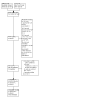

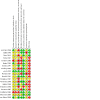
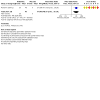
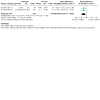

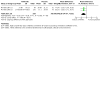
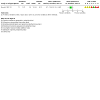


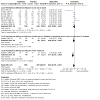
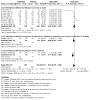

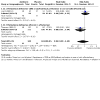

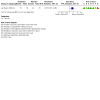

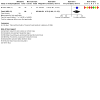

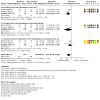



Update of
- doi: 10.1002/14651858.CD015254
References
References to studies included in this review
Ardehali 2008 {published data only}
-
- Ardehali MM, Seraj JM, Asiabar MK, Adibi H. The possible role of gastroesophageal reflux disease in children suffering from chronic otitis media with effusion. Acta Medica Iranica 2008;46(1):33-7. [CENTRAL: CN-00708224] [EMBASE: 351792703]
Balle 1990 {published data only}
-
- Balle VH, Stangerup SE, Sederberg-Olsen J, Thomsen J, Vejlsgaard R. Amoxicillin/clavulanate treatment in secretory otitis media. Bacteriological findings in the nasopharynx. Acta Oto-laryngologica 1990;110(3-4):274-8. [CENTRAL: CN-00071274] [PMID: ] - PubMed
Chen 2013 {published data only}
-
- Chen K, Wu X, Jiang G, Du J, Jiang H. Low dose macrolide administration for long term is effective for otitis media with effusion in children. Auris, Nasus, Larynx 2013;40(1):46-50. [CENTRAL: CN-00880075] [PMID: ] - PubMed
Endo 1997 {published data only}
-
- Endo LH, Antunes AB, Vidolin C, Bilecki MM, Magalhaes KVB. Secretory media otitis: clinical treatment vs placebo [Otite media secretora: tratamento clinco versus placebo]. Revista Brasileira de Otorrinolaringologia 1997;63(2):116-9. [CENTRAL: CN-00316174]
Ernston 1985 {published data only}
-
- Ernstson S, Anari M. Cefaclor in the treatment of otitis media with effusion. Acta Oto-laryngologica. Supplementum 1985;424:17-21. [CENTRAL: CN-00040675] [PMID: ] - PubMed
Healy 1984 {published data only}
-
- Healy GB. Antimicrobial therapy of chronic otitis media with effusion. International Journal of Pediatric Otorhinolaryngology 1984;8(1):13-7. [CENTRAL: CN-00036115] [PMID: ] - PubMed
Hemlin 1997 {published data only}
-
- Hemlin C, Carenfelt C, Papatziamos G. Single dose of betamethasone in combined medical treatment of secretory otitis media. Annals of Otology, Rhinology, and Laryngology 1997;106(5):359-63. [CENTRAL: CN-00139646] [PMID: ] - PubMed
-
- Papatziamos G, Hemlin C, Carenfelt C. Recent Advances in Otitis Media. Kugler Publications, Amsterdam/New York, 1994.
Karlidag 2002 {published data only}
-
- Karlidag T, Kaygusuz I, Gok U, Yalcin S, Keles E, Ozturk L. The efficacy of combining antibiotic treatment with topical intranasal steroid administration in the treatment of chronic otitis media with effusion [Efuzyonlu otitis media tedavisinde antibiyotik ile birlikte intranazal steroid kullaniminin etkinligi]. Kulak Burun Bogaz Ihtisas Dergisi: KBB [Journal of Ear, Nose, and Throat] 2002;9(4):257-62. [CENTRAL: CN-00411239] [PMID: ] - PubMed
Leach 2008 {published data only}
-
- Leach AJ, Morris PS, Mathews JD, Hayhurst B, Koops H, Melder A, et al. Compared to placebo, long-term antibiotics resolve otitis media with effusion (OME) and prevent acute otitis media with perforation (AOMwiP) in a high-risk population: a randomized controlled trial. BMC Pediatrics 2008;8:23. [CENTRAL: CN-00639992] [EMBASE: 2008359321] [PMID: ] - PMC - PubMed
-
- NCT00539149. Long-term antibiotics for treatment and prevention of otitis media in aborignal children [Amoxycillin versus placebo for resolution of otitis media with effusion and prevention of acute otitis media with perforation in aboriginal infants: a randomised controlled trial]. https://clinicaltrials.gov/show/NCT00539149 (first received 4 October 2007). [CENTRAL: CN-00652606]
Mandel 1987 {published data only}
-
- Cantekin EI, McGuire TW, Griffith TL. Antimicrobial therapy for otitis media with effusion ('secretory' otitis media). JAMA 1991;266(23):3309-17. [CENTRAL: CN-00079882] [PMID: ] - PubMed
-
- Mandel EM, Rockette HE, Bluestone CD, Paradise JL, Nozza RJ. Efficacy of amoxicillin with and without decongestant-antihistamine for otitis media with effusion in children. Results of a double-blind, randomized trial. New England Journal of Medicine 1987;316(8):432-7. [CENTRAL: CN-00046384] [PMID: ] - PubMed
Mandel 1991 {published data only}
-
- Mandel EM, Rockette HE, Paradise JL, Bluestone CD, Nozza RJ. Comparative efficacy of erythromycin-sulfisoxazole, cefaclor, amoxicillin or placebo for otitis media with effusion in children. Pediatric Infectious Disease Journal 1991;10(12):899-906. [CENTRAL: CN-00080817] [PMID: ] - PubMed
Manrique 1987 {published data only}
-
- Manrique MJ, Hernández J, Huarte A, Rivera R, García-Tapia R. Treatment of secretory otitis media with Ambroxol [Tratamiento de la otitis serosa con Ambroxol]. Acta Pediatrica Española 1987;45(1):17-20.
Marchisio 1998 {published data only}
-
- Marchisio P, Principi N, Passali D, Salpietro DC, Boschi G, Chetrì G, et al. Epidemiology and treatment of otitis media with effusion in children in the first year of primary school. Acta Oto-Laryngologica 1998;118(4):557-62. [CENTRAL: CN-00154484] [EMBASE: 1998254893] [PMID: ] - PubMed
Møller 1990 {published data only}
-
- Moller P, Dingsor G. Otitis media with effusion: can erythromycin reduce the need for ventilating tubes? Journal of Laryngology and Otology 1990;104(3):200-2. [CENTRAL: CN-00067688] [PMID: ] - PubMed
Podoshin 1990 {published data only}
-
- Podoshin L, Fradis M, Ben-David Y, Faraggi D. The efficacy of oral steroids in the treatment of persistent otitis media with effusion. Archives of Otolaryngology-Head & Neck Surgery 1990;116(12):1404-6. [CENTRAL: CN-00071613] [PMID: ] - PubMed
Puhakka 1985 {published data only}
-
- Puhakka H, Haapaniemi J, Tuohimaa P, Ruuskanen O, Eskola J. Peroral prednisolone in the treatment of middle-ear effusion in children: a double-blind study. Auris, Nasus, Larynx 1985;12 Suppl 1:S268-71. [CENTRAL: CN-00043250] [EMBASE: 16731329] [PMID: ] - PubMed
Sundberg 1984 {published data only}
-
- Sundberg L, Cederberg A, Eden T, Ernstson S. The effect of erythromycin on the nasopharyngeal pathogens in children with secretory otitis media. Acta Oto-Laryngologica 1984;97(3-4):379-83. - PubMed
Thomsen 1989 {published data only}
-
- Thomsen J, Sederberg-Olsen J, Balle V, Vejlsgaard R, Stangerup SE, Bondesson G. Antibiotic treatment of children with secretory otitis media. A randomized, double-blind, placebo-controlled study. Archives of Otolaryngology-Head & Neck Surgery 1989;115(4):447-51. [CENTRAL: CN-00058572] [PMID: ] - PubMed
-
- Thomsen J, Sederberg-Olsen J, Stangerup SE, Balle V, Vejlsgaard R. Long-term antibiotic treatment of children with secretory otitis media: a double-blind placebo-controlled study. Acta Oto-Laryngologica. Supplementum 1988;449:49-50. [CENTRAL: CN-00056944] [PMID: ] - PubMed
van Balen 1996 {published data only}
-
- Balen FA, Melker RA, Touw-Otten FW. Double-blind randomised trial of co-amoxiclav versus placebo for persistent otitis media with effusion in general practice. Lancet 1996;348(9029):713-6. [CENTRAL: CN-00129985] [EMBASE: 1996280110] [PMID: ] - PubMed
References to studies excluded from this review
Berman 1990 {published data only}
-
- Berman S, Grose K, Nuss R, Huber-Navin C, Roark R, Gabbard SA, et al. Management of chronic middle ear effusion with prednisone combined with trimethoprim-sulfamethoxazole. Pediatric Infectious Disease Journal 1990;9(8):533-8. [CENTRAL: CN-00071176] [PMID: ] - PubMed
Bernard 1991 {published data only}
-
- Bernard PA, Stenstrom RJ, Feldman W, Durieux-Smith A. Randomized, controlled trial comparing long-term sulfonamide therapy to ventilation tubes for otitis media with effusion. Pediatrics 1991;88(2):215-22. [CENTRAL: CN-00077175] [PMID: ] - PubMed
-
- Feldman W, Bernard P, Smith A, Stenstrom R. Sulfonamide prophylaxis vs ventilation tubes in hearing-loss due to recurrent otitis-media with effusion (Rome) - preliminary results of a randomized controlled trial. Clinical and Investigative Medicine [Medecine Clinique et Experimentale] 1987;4:A33. [CENTRAL: CN-02494379]
-
- Feldman W, Bernard P, Smith A, Stenstrom R. Sulfonamide prophylaxis vs ventilation tubes in hearing-loss due to recurrent otitis-media with effusion - preliminary results of a randomized controlled trial. American Journal of Diseases of Children 1987;4:389-9. [CENTRAL: CN-02494378]
-
- Feldman W, Bernard P, Smith A, Stenstrom R. Ventilation tubes vs sulfonamide prophylaxis for recurrent acute otitis-media or serious otitis-media - follow-up on a randomized, controlled trial. American Journal of Diseases of Children 1988;4(4):407-7. [CENTRAL: CN-02494377]
Choung 2008 {published data only}
Corwin 1986 {published data only}
-
- Corwin MJ, Weiner LB, Daniels D. Efficacy of oral antibiotics for the treatment of persistent otitis media with effusion. International Journal of Pediatric Otorhinolaryngology 1986;11(2):109-12. [CENTRAL: CN-00044237] [PMID: ] - PubMed
-
- Corwin MJ, Weiner LB, Daniels DA, Daniels DA. Effects of oral antibiotics on the outcome of serous otitis media. Pediatric Research 1982;16:238A. [CENTRAL: CN-00449256]
Daly 1991 {published data only}
-
- Daly K, Giebink GS, Batalden PB, Anderson RS, Le CT, Lindgren B, et al. Resolution of otitis media with effusion with the use of a stepped treatment regimen of trimethoprim-sulfamethoxazole and prednisone. Pediatric Infectious Disease Journal 1991;10(7):500-6. [CENTRAL: CN-00077629] [PMID: ] - PubMed
-
- Daly K, Giebink GS, Lindgren B, Anderson RS. Controlled clinical trial for prevention of chronic otitis media with effusion. In: Lim DJ, Bluestone CD, Klein JO , editors(s). Recent Advances on Otitis Media: Proceedings of the 4th International Symposium; 1987 Jun 1-4; Toronto (ON). 1987:247-50. [CENTRAL: CN-00452502]
de Castro 1982 {published data only}
-
- Castro FJ, Jaeger RW, Martin L, Temeck JW, Tournour B. Serous otitis media. A double-blind trial with sulfisoxazole. Missouri Medicine 1982;79(9):629-30. [CENTRAL: CN-00029746] [EMBASE: 13245698] [PMID: ] - PubMed
Donaldson 1990 {published data only}
-
- Donaldson JD, Martin GF, Maltby CC, Seywerd EB. The efficacy of pulse-dosed antibiotic therapy in the management of persistent otitis media with effusion. Journal of Otolaryngology 1990;19(3):175-8. [CENTRAL: CN-00068309] [PMID: ] - PubMed
Eiden 1997 {published data only}
-
- Eiden P. Antibiotic therapy for otitis media infection with effusion in children can make surgery unnecessary. Deutsche Apotheker Zeitung 1997;137(8):41-2.
Ferrara 2005 {published data only}
-
- Ferrara S, Sammartano D, Ferrara P. Long-term management of recurrent otitis media with effusion in children. In: XVIII IFOS World Congress; 2005 Jun 25-30; Rome (Italy). 2005. [CENTRAL: CN-00526409]
Fujita 1994 {published data only}
-
- Fujita A, Kurata K, Takahashi H, Takagita S. Clinical efficacy of clarithromycin treatment of refractory otitis media with effusion. Practica Otologica 1994;87(9):1287-91.
Gaskins 1982 {published data only}
-
- Gaskins JD, Holt RJ, Kyong CU, Weart CW, Ward J. Chemoprophylaxis of recurrent otitis media using trimethoprim/sulfamethoxazole. Drug Intelligence & Clinical Pharmacy 1982;16(5):387-90. [CENTRAL: CN-00028043] [PMID: ] - PubMed
Gasper 2003 {published data only}
-
- Gasper K, St Anna L, Montgomery L. Are antibiotics effective for otitis media with effusion? Journal of Family Practice 2003;52(4):321-3. [EMBASE: 36427691] - PubMed
Gibson 1996 {published data only}
-
- Gibson PG, Stuart JE, Wlodarczyk J, Olson LG, Hensley MJ. Nasal inflammation and chronic ear disease in Australian Aboriginal children. Journal of Paediatrics and Child Health 1996;32(2):143-7. [CENTRAL: CN-00131589] [PMID: ] - PubMed
Giebink 1990 {published data only}
-
- Giebink GC, Batalden PB, Le CT, Russ JN, Knox JK, Anderson RS. Randomized controlled trial comparing trimethoprim-sulfamethoxazole, prednisone, ibuprofen, and no treatment in chronic otitis media with effusion. In: Lim DJ, Bluestone CD, Klein JO , editors(s). Recent Advances Otitis Media: Proceedings of the Fourth International Symposium; 1988 Jun 1-4 Toronto (Canada). 1988:240-4. [CENTRAL: CN-00452593]
-
- Giebink GS, Batalden PB, Le CT, Lassman FM, Buran DJ, Seltz AE. A controlled trial comparing three treatments for chronic otitis media with effusion. Pediatric Infectious Disease Journal 1990;9(1):33-40. [CENTRAL: CN-00065358] [PMID: ] - PubMed
Hozawa 2001 {published data only}
-
- Hozawa T. Evidence-based macrolide therapy for children with serous otitis media. Japanese Journal of Antibiotics 2001;54(Suppl C):30-2. [EMBASE: 36495134] - PubMed
Iino 1989 {published data only}
-
- Iino Y, Ishitoya J, Ikeda M, Ito Y, Usami M, Kawashiro N, et al. Factors on delayed recovery of otitis media with effusion in children--clinical and bacteriological study. Nihon Jibiinkoka Gakkai Kaiho 1989;92(8):1183-91. [CENTRAL: CN-00063873] [PMID: ] - PubMed
Iino 2001 {published data only}
-
- Iino Y. Efficacy of macrolide therapy for children with serous otitis media. Japanese Journal of Antibiotics 2001;54 Suppl C:23-5. [EMBASE: 36495133] [PMID: ] - PubMed
Kobayashi 2001 {published data only}
-
- Kobayashi K. Applicability of long-term low-dosage macrolide therapy for children with serous otitis media. Japanese Journal of Antibiotics 2001;54 Suppl C:26-9. [PMID: ] - PubMed
Kuriyama 1980 {published data only}
-
- Kuriyama K. Synergistic effect of antibiotics and Chinese drug on recurrent otitis media. Otolaryngology 1980;52(9):617-22. [EMBASE: 11228874]
Leonetti 1988 {published data only}
-
- Leonetti JP, Stankiewicz JA. Antimicrobial prophylaxis for recurrent otitis media. Otolaryngology - Head & Neck Surgery 1988;99(1):81-2. [PMID: ] - PubMed
Marks 1981 {published data only}
-
- Marks NJ, Mills RP, Shaheen OH. A controlled trial of cotrimoxazole therapy in serous otitis media. Journal of Laryngology and Otology 1981;95(10):1003-9. [CENTRAL: CN-00026372] [EMBASE: 1982075258] [PMID: ] - PubMed
Paradise 1997 {published data only}
-
- Paradise J, Campbell T, Dollaghan C, Feldman H, Bernard B, Colborn K, et al. Receptive vocabulary, cognition, and parent-rated behavior at age 3 years in relation to otitis media in the first 3 years of life. In: Abstract Book of the Association of Health Service Research. Vol. 14. 1997:350-1. [CENTRAL: CN-00452820]
Parlea 2012 {published data only}
Perrin 1974 {published data only}
-
- Perrin JM, Charney E, MacWhinney JBJ, McInerny TK, Miller RL, Nazarian LF. Sulfisoxazole as chemoprophylaxis for recurrent otitis media. A double-blind crossover study in pediatric practice. New England Journal of Medicine 1974;291(13):664-7. [CENTRAL: CN-00010786] [PMID: ] - PubMed
Persico 1978 {published data only}
-
- Persico M, Podoshin L, Fradis M, Fradis M. Otitis media with effusion: a steroid and antibiotic therapeutic trial before surgery. Annals of Otology, Rhinology, and Laryngology 1978;87:191-5. [CENTRAL: CN-00449363] [PMID: ] - PubMed
Principi 1989 {published data only}
-
- Principi N, Marchisio P, Massironi E, Grasso RM, Filiberti G. Prophylaxis of recurrent acute otitis media and middle-ear effusion. Comparison of amoxicillin with sulfamethoxazole and trimethoprim. American Journal of Diseases of Children 1989;143(12):1414-8. [CENTRAL: CN-00063984] [PMID: ] - PubMed
Roark 1997 {published data only}
-
- Roark R, Berman S. Continuous twice daily or once daily amoxicillin prophylaxis compared with placebo for children with recurrent acute otitis media. Pediatric Infectious Disease Journal 1997;16(4):376-81. [CENTRAL: CN-00138754] [PMID: ] - PubMed
Rohail 2006 {published data only}
-
- Rohail A, Gill ZI, Butt MR. A comparison of medical treatment versus surgical treatment for the management of otitis media with effusion. Annals of King Edward Medical College 2006;12(1):64-7. [CENTRAL: CN-00597368]
Schloss 1988 {published data only}
-
- Schloss MD, Dempsey EE, Rishikof E, Sorga S, Grace MGA. Double blind study comparing erythromycin-sulfisoxazole (Pediazole) TID to placebo in chronic otitis media with effusion. In: Lim DJ, Bluestone CD, Klein JO , editors(s). Recent Advances on Otitis Media: Proceedings of the 4th International Symposium; 1987 Jun 1-4; Toronto (ON). 1988:261-3. [CENTRAL: CN-00452893]
-
- Schloss MD, Rishikof E, Sorger S, Dempsey EE, Grace M. A double-blind study comparing erythromycin-sulfisoxazole (Pediazole (R)) t.i.d. with placebo in chronic otitis media with effusion. Today's Therapeutic Trends 1988;5(4):43-56. [CENTRAL: CN-00192403] [EMBASE: 1988100915]
Schwartz 1982 {published data only}
-
- Schwartz RH, Rodriguez WJ. Trimethoprim-sulfamethoxazole treatment of persistent otitis media with effusion. Pediatric Infectious Disease Journal 1982;1(5):333-5. [CENTRAL: CN-00030082] [PMID: ] - PubMed
Schwartz 1982a {published data only}
Shubich 1996 {published data only}
-
- Shubich I. Otitis media with effusion and allergy control in children: a prospective study. In: Sixth International Symposium on Otitis Media; 1996; Fort Lauderdale (FL). 1996:173-4. [CENTRAL: CN-00452904]
Smales 1992 {published data only}
-
- Smales O. Antibiotics for otitis media with effusion. New Zealand Medical Journal 1992;105(927):42. [PMID: ] - PubMed
Stenstrom 2005 {published data only}
-
- Stenstrom R, Pless IB, Bernard P. Hearing thresholds and tympanic membrane sequelae in children managed medically or surgically for otitis media with effusion. Archives of Pediatrics & Adolescent Medicine 2005;159(12):1151-6. [CENTRAL: CN-00532329] [PMID: ] - PubMed
Tracy 1995 {published data only}
-
- Tracy JM, Demain JG, Hoffman K, Goetz DW. Intranasal beclomethasone as an adjunct to treatment of chronic middle ear effusion. Annals of Allergy, Asthma & Immunology 1995;74:59. [CENTRAL: CN-00285148] - PubMed
-
- Tracy JM, Demain JG, Hoffman KM, Goetz DW. Intranasal beclomethasone as an adjunct to treatment of chronic middle ear effusion. Annals of Allergy, Asthma & Immunology 1998;80(2):198-206. [CENTRAL: CN-00148310] [PMID: ] - PubMed
van Balen 1997 {published data only}
-
- Balen FA. Antibiotics in otitis media with effusion [Antibiotica bij otitis media met effusie]. Nederlands Tijdschrift voor Geneeskunde 1997;141(8):401-2. [PMID: ] - PubMed
Varsano 1985 {published data only}
-
- Varsano I, Volovitz B, Mimouni F. Sulfisoxazole prophylaxis of middle ear effusion and recurrent acute otitis media. American Journal of Diseases of Children 1985;139(6):632-5. [CENTRAL: CN-00038335] [PMID: ] - PubMed
Velepic 2011 {published data only}
-
- Velepic M, Starcevic R, Bonifacic M, Ticac R, Kujundzic M, Udovic DS, et al. The clinical status of the eardrum: an inclusion criterion for the treatment of chronic secretory otitis media in children. International Journal of Pediatric Otorhinolaryngology 2011;75(5):686-90. [CENTRAL: CN-00784332] [EMBASE: 51315541] [PMID: ] - PubMed
Yeldandi 2001 {published data only}
-
- Yeldandi V, MacLeod C, Mulvaney AM. Open-label, randomised, comparative study of usual care with or without clarithromycin suspension in serous otitis media with inflammation. In: 22nd International Congress of Chemotherapy; 2001 Jun 30-Jul 3; Amsterdam (the Netherlands). 2001. [ABSTRACT NO.: P10.009] [CENTRAL: CN-00453008]
Yin 2002 {published data only}
-
- Yin TF, Tang QL, Xie DH, Lu YD. Efficacy of cefaclor in treating children with secretory otitis media. Shanghai Medicine 2002;23(2):65-6. [CENTRAL: CN-00416980]
Zocconi 1994 {published data only}
-
- Zocconi E. Antibiotics and oral steroids in the treatment of otitis media with effusion. Pediatria Medica e Chirurgica 1994;16(3):273-5. - PubMed
References to studies awaiting assessment
Koay 1998 {published data only}
-
- Koay B, Commins DJ, Bates S, Mitchell B, Moore A, Bates G, et al. In search of a medical treatment for otitis media with effusion (OME): a randomised double-blind controlled trial (RCT). In: 7th International Congress of Pediatric Otorhinolaryngology. Helsinki, Finland, 7-10 June, 1998. 1998:64. [ABSTRACT NUMBER: 289] [CENTRAL: CN-00292550]
Tawfik 2002 {published data only}
-
- Tawfik S, Belal A, Sorour W. A comparative study of the different treatment modalities of otitis media with effusion in children. In: 8th International Congress of Paediatric Otorhinolaryngology (ESPO). Oxford, UK, 11-14 September, 2002. 2002:151, Abstract No. P2.26. [CENTRAL: CN-00508402]
Additional references
Abidin 1995
-
- Abidin RR. Parenting Stress Index: Professional Manual. Odessa, FL: Psychological Assessment Resources, 1995.
Achenbach 2011
-
- Achenbach T M. Child Behavior Checklist. In: Kreutzer JS, DeLuca J, Caplan B, editors(s). Encyclopedia of Clinical Neuropsychology. New York, NY: Springer, 2011.
Bayley 2006
-
- Bayley N. Bayley Scales of Infant and Toddler Development. San Antonio, TX: Harcourt Assessment, Inc, 2006.
Bruce 2015
Cantekin 1983
-
- Cantekin EI. Algorithm for diagnosis of otitis media with effusion. Annals of Otology, Rhinology & Laryngology 1983;92(6 Suppl):6-6. [DOI: 10.1177/00034894830920S603] - DOI
Cochrane ENT 2020
-
- Cochrane ENT. Otitis media with effusion: a project to prioritise Cochrane systematic reviews. https://ent.cochrane.org/otitis-media-effusion-ome-glue-ear 2020 (accessed 3 November 2021).
Daniel 2012
Dunn 2007
-
- Dunn LM, Dunn DM. Peabody Picture Vocabulary Test (PPVT™-4). 4th edition. Pearson Education, 2007.
Fekkes 2000
-
- Fekkes M, Theunissen NC, Brugman E, Veen S, Verrips EG, Koopman HM, et al. Development and psychometric evaluation of the TAPQOL: a health-related quality of life instrument for 1–5-year-old children. Quality of Life Research 2000;9:961-72. - PubMed
Flynn 2009
Galbraith 2022
Goodman 1997
-
- Goodman R. The Strengths and Difficulties Questionnaire: a research note. Journal of Child Psychology and Psychiatry 1997;38:581-6. - PubMed
Gresham 1990
-
- Gresham FM, Elliott SN. Social Skills Rating System. Circle Pines, MN: American Guidance Service, 1990.
Griffiths 1996
-
- Griffiths R. The Griffiths Mental Development Scales from Birth to Two Years, Manual, the 1996 revision. Henley: Association for Research in Infant and Child Development, Test Agency, 1996.
Haggard 2003
-
- Haggard MP, Smith SC, Nicholls EE. Quality of life and child behaviour. In: Rosenfeld RM, Bluestone CD, editors(s). Evidence-Based Otitis Media. 2nd edition. Hamilton, Ontario: BC Decker Inc, 2003:401-29. [https://researchonline.lshtm.ac.uk/id/eprint/15108]
Handbook 2011
-
- Higgins JPT, Green S (editors). Cochrane Handbook for Systematic Reviews of Interventions Version 5.1.0 [updated March 2011]. The Cochrane Collaboration, 2011. Available from www.cochrane-handbook.org.
Hedrick 1984
-
- Hedrick DL, Prather EM, Tobin AR. Sequenced Inventory of Communication Development. Seattle, WA: University of Washington Press, 1984.
Higgins 2021
-
- Higgins JP, Thomas J, Chandler J, Cumpston M, Li T, Page MJ, Welch VA, editor(s). Cochrane Handbook for Systematic Reviews of Interventions Version 6.2 (updated February 2021). Cochrane, 2021. Available from training.cochrane.org/handbook. - PMC - PubMed
Jellinek 1988
Kreiner‐Møller 2012
Landgraf 1994
-
- Landgraf JM. The Infant/Toddler Child Health Questionnaire: conceptual framework, logic content, and preliminary psychometric results. Boston: Health Act, 1994.
Landgraf 1996
-
- Landgraf JL, Abetz L, Ware JE. The CHQ User’s Manual. Boston: The Health Institute, New England Medical Center, 1996.
Lefebvre 2020
-
- Lefebvre C, Glanville J, Briscoe S, Littlewood A, Marshall C, Metzendorf M-I, et al. Chapter 4: Searching for and selecting studies. In: Higgins JP, Thomas J, Chandler J, Cumpston M, Li T, Page MJ, Welch VA, editor(s). Cochrane Handbook for Systematic Reviews of Interventions Version 6.2 (updated February 2021). Cochrane, 2021. Available from training.cochrane.org/handbook.
Liu 2020
-
- Liu PZ, Ismail-Koch H, Stephenson K, Donne AJ, Fergie N, Derry J, et al. A core outcome set for research on the management of otitis media with effusion in otherwise-healthy children. International Journal of Pediatric Otorhinolaryngology 2020;134:110029. [DOI: 10.1016/j.ijporl.2020.110029] - DOI - PubMed
MacKeith 2022a
MacKeith 2022b
Maris 2014
Marseglia 2008
Marshall 2018
McCarthy 1972
-
- McCarthy D. Manual for the McCarthy Scales of Children's Abilities. New York: Psychological Corp, 1972.
McDonald 2017
-
- McDonald S, Noel-Storr AH, Thomas J. Harnessing the efficiencies of machine learning and Cochrane Crowd to identify randomised trials for individual Cochrane reviews. In: Global Evidence Summit; 2017 Sep 13-17; Cape Town, South Africa. 2017.
Mulvaney 2022a
NICE 2008
-
- National Institute for Health and Care Excellence. Otitis media with effusion in under 12s: surgery. Clinical guideline [CG60]. Published: 27 February 2008. https://www.nice.org.uk/guidance/cg60. - PubMed
NICE 2023
-
- National Institute for Health and Care Excellence. Otitis media with effusion in under 12s. NICE guideline [NG233]. Published: 30 August 2023. https://www.nice.org.uk/guidance/ng233. - PubMed
Noel‐Storr 2018
-
- Noel-Storr AH. Cochrane Crowd: new ways of working together to produce health evidence. In: Evidence Live; 2018 Jun 18-20; Oxford, UK. 2018.
Park 2004
Poetker 2005
-
- Poetker DM, Lindstrom DR, Edmiston CE, Krepel CJ, Link TR, Kerschner JE. Microbiology of middle ear effusions from 292 patients undergoing tympanostomy tube placement for middle ear disease. International Journal of Pediatric Otorhinolaryngology 2005;69(6):799-804. [DOI: 10.1016/j.ijporl.2005.01.012] - DOI - PubMed
Rabin 2001
-
- Rabin R, Charro F. EQ-5D: a measure of health status from the EuroQol Group. Annals of Medicine 2001;33(5):337-43. - PubMed
RevMan 2014 [Computer program]
-
- Review Manager (RevMan). Version 5.3. Copenhagen: The Nordic Cochrane Centre, The Cochrane Collaboration, 2014.
Reynell 1985
-
- Reynell JH. Reynell Development Language Scales Manual. Windsor, UK: NFER-NELSON, 1985.
Rosenfeld 1997
Rosenfeld 2000
-
- Rosenfeld RM, Bhaya MH, Bower CM, Brookhouser PE, Casselbrant ML, Chan KH, et al. Impact of tympanostomy tubes on child quality of life. Archives of Otolaryngology--Head & Neck Surgery 2000;126:585-92. - PubMed
Rosenfeld 2003
Rosenfeld 2016
-
- Rosenfeld RM, Shin JJ, Schwartz SR, Coggins R, Gagnon L, Hackell JM, et al. Clinical practice guideline: otitis media with effusion (update). Otolaryngology - Head & Neck Surgery 2016;154(1 Suppl):S1-S41. - PubMed
Schlichting 2007
-
- Schlichting JEPT, Lutje Spelberg HC. Lexilijst Begrip: an instrument to investigate language comprehension in children aged 15-25 months in the context of early identification. Amsterdam: Pearson Assessment & Information BV, 2007.
Schlichting 2010
-
- Schlichting JEPT, Lutje Spelberg HC. Schlichting Test for Language Comprehension; Instruction Manual. Woooden: Bohn Stafleu van Loghum, 2010.
Schmalbach 2021
-
- Schmalbach CE, Brereton J, Bowman C, Denneny III JC. American Academy of Otolaryngology–Head and Neck Surgery/Foundation Reg-ent Registry: Purpose, Properties, and Priorities. Otolaryngology–Head and Neck Surgery 2021;164(5):964-71. - PubMed
Seppanen 2020
-
- Seppanen E, Thornton R, North H, Corscadden KJ, Wiertsema S, Vijayasekaran S, et al. Bacterial reservoirs in the middle ear of otitis-prone children are associated with repeat ventilation tube insertion. Pediatric Infectious Disease Journal 2020;39(2):91-6. [DOI: 10.1097/INF.0000000000002541] - DOI - PubMed
Thomas 2017
-
- Thomas J, Noel-Storr AH, Marshall I, Wallace B, McDonald S, Mavergames C, et al, Living Systematic Review Network. Living systematic reviews 2: combining human and machine effort. Journal of Clinical Epidemiology 2017;91:31-7. - PubMed
TNO 1997
-
- TNO—Prevention and Health/LUMC. TAIQOL—Questionnaire for parents of children aged 1—5 years. Leiden, The Netherlands: Leiden University Medical Center, 1997.
Verrips 1998
-
- Verrips GH, Vogels AGC, Verloove-Vanhorick SP, Fekkes M, Koopman HM, Kamphuis RP, et al. Health-related quality of life measure for children - the TACQOL. Journal of Applied Therapeutics 1998;1(4):357-60.
Wallace 2017
-
- Wallace BC, Noel-Storr AH, Marshall IJ, Cohen AM, Smalheiser NR, Thomas J. Identifying reports of randomized controlled trials (RCTs) via a hybrid machine learning and crowdsourcing approach. Journal of the American Medical Informatics Association 2017;24(6):1165-8. [DOI: 10.1093/jamia/ocx053] - DOI - PMC - PubMed
Williamson 2011
Zernotti 2017
Zimmerman 1992
-
- Zimmerman IL, Steiner VG, Pond RE. Preschool Language Scale-3. San Antonio, TX: The Psychological Corporation, 1992.
References to other published versions of this review
Mulvaney 2022b
Publication types
MeSH terms
Substances
Associated data
LinkOut - more resources
Full Text Sources
Medical
Research Materials
Miscellaneous

